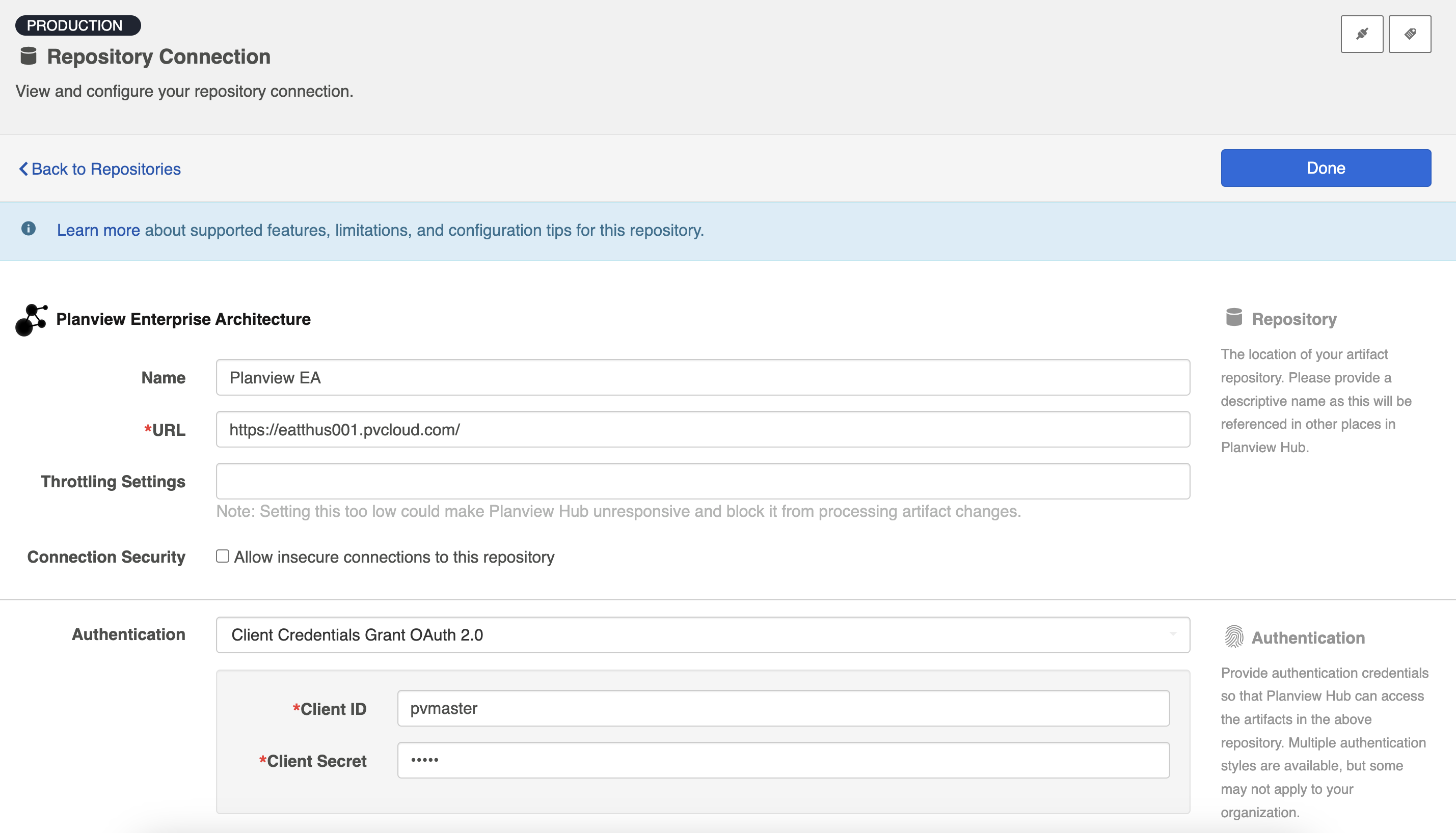Planview Enterprise Architecture

Overview
Planview Enterprise Architecture (EA) provides stakeholders with powerful visualizations to jointly create technology plans that advance capabilities and deliver digital strategies. Planview Enterprise Architecture helps standardize and organize IT infrastructure, application capabilities, and governance standards to align with and drive business goals.
By synchronizing Planview EA with Planview Hub, practitioners can collaborate on artifacts each from within their tool of choice, with data and handoffs flowing seamlessly between them.
For example:
-
The PMO uses a PPM tool such as Planview AgilePlace to brainstorm and score ideas against each other.
-
Hub mirrors the selected ideas to Planview EA to get further analyzed, assessed, and prioritized.
-
When the idea is ready to be developed, the work needs to synchronize to the development team’s Agile planning tool of choice (e.g., Jira) where the development team may break them down into finer granularity items.
Key Features and Benefits
-
Synchronizes artifacts across the lifecycle, allowing information to flow freely between Planview EA and other tools.
-
Improves collaboration between the PMO, development, test, the service desk and more.
-
Provides visibility to the PMO office on the status of ongoing projects.
-
Supports cross-tool traceability and reporting, removing the need for manual processes and spreadsheets.
Connector Setup Details
This section describes the basic steps needed to prepare your Planview EA instance for use with Hub. Note that additional fields for synchronization or configuration of queries may be required depending on the requirements of your integration.
Minimal User Permissions & Hub User
We recommend that you create a new user within your external tool, to be used only for your Hub integration. This is the user information you will enter when setting up your repository connection within Planview Hub. By creating a new user, you will ensure that the correct permissions are granted, and allow for traceability of the modifications that are made by the synchronization.
In general, your user account should have sufficient permissions to create, read, and update artifacts in your repository. However, depending on the use case, your user may need different permissions. For example, if you are only interested in flowing data out of your repository, your user may not need to have full CRUD access, as the 'create' and 'update' permissions may not be needed.
Your user should have a secure password or token. Please be aware that Hub will not allow you to save a repository connection utilizing a weak password/token, such as 'tasktop.'
The user must be a member of one of the following user groups or a member of a group with the same privileges to use the REST API:
-
REST API Reader. This group has the readRestApi privilege, which allows users to read data (GET requests).
-
REST API Updater. This group has both the readRestApi privilege, and the updateRestApi privilege, which allows users to update repository data (POST and DELETE requests).
To create, update, and delete objects in the repository, you must have the relevant privileges for those actions in addition to the API-specific roles. Refer to Security and Permissions for detailed information.
Check notes on type-level security in About the API for type permissions.
Connecting to the Planview Enterprise Architecture Repository
Client Credentials Grant OAuth 2.0 Authentication
Required Fields:
-
URL
-
Example Format: https://server.pvcloud.com/
-
-
Client ID
-
Client Secret
Optional Fields:
- Throttling Settings: This field indicates the number of API calls that can be made per minute. See details here.
- Note: This field should only be set under the guidance of customer care as the ideal value is highly dependent on each customer's unique environment.
- Connection Security: If checked, insecure connections to this repository will be allowed. See details here.
Learn how to set up a Client ID and Client Secret here.

SSO Authentication
Additionally, Planview EA supports the following SSO implementations:
- Script (HTTP cookies)
- X.509 Certificate
Learn more about how to set up your repository in Planview Hub here.
Other Configuration Settings
Active Fields
Only active fields in Planview EA are supported.
Persons
Persons are created as a Person component type in the EA repository by the repository owner as a part of the master data setup. If persons are not found while synchronizing the Person field, it will not be created by the connector.
Comments
Standard comments are not supported. Comments are supported using the OOTB String field.
Learn more about how to configure comments in Planview Hub here.
Attachments
Standard attachments are not supported.
Person Reconciliation
For person reconciliation, the following fields are available:
|
Fields Used for Hub’s Default Person Reconciliation Algorithm |
Field Names for Person Reconciliation Extensions (Note that these are case-sensitive) |
Label in Planview EA |
|---|---|---|
|
ID |
ID |
ID |
|
|
emailAddress |
Email Address |
|
UserName |
username |
Username |
|
N/A |
fullName |
Display Name |
Learn more about how to configure person reconciliation in Planview Hub here.
Supported Features
Special Features Supported
You can learn more about special features in Planview Hub here.
|
Feature |
Custom Type Supported? |
Applicable Hub Version |
Applicable Repository Versions |
|---|---|---|---|
|
|
N/A |
Planview Hub: 24.1 and later |
Any supported repository version: |
|
|
|||
|
|
Supported Artifacts
Supported Work Items
Learn about the difference between containers and work items in Planview Hub here.
|
Supported Work Item Type |
Applicable Hub Versions |
Applicable Repository Versions |
Unique URL? |
|---|---|---|---|
|
Need |
Planview Hub: 24.1 and later |
Any supported repository version: |
Yes |
Supported Containers
Learn more about containment in Planview Hub here.
|
Containers that can synchronize between repositories |
Applicable Hub Versions |
Applicable Repository Versions |
Unique URL? |
|---|---|---|---|
|
N/A |
|||
|
Containers used to define the boundary of a collection (when clicking 'Manage Projects' on a collection) |
|
|
|
|
N/A (entire Planview EA repository is used) |
|||
|
Containers used for artifact routing |
|
|
|
|
N/A (entire Planview EA repository is used) |
Supported Field Types
Note: If one field of a given type is supported, others that are also that type in theory should also work. However, sometimes there are instances in which this is not the case due to the repository. So, while we can claim support for fields at the type level, there is a chance that some specific fields of a given type will not synchronize properly.
|
Field Type |
Does Hub support custom fields of this type? |
How is field type referenced in the repository? |
Sample Repository Fields Supported |
Particular Repository Fields NOT Supported |
|---|---|---|---|---|
|
|
|
String Note |
Name Comments |
|
|
|
|
Enumeration |
|
|
|
|
|
Date |
|
|
|
|
|
Date |
|
|
|
|
N/A |
Person |
|
|
|
|
N/A |
Person |
|
|
|
|
|
Link |
Journal URL Location |
|
|
|
|
Link List |
|
|
|
|
|
|
|
|
 Boolean Boolean |
||||
 Long Long |
||||
 Double Double |
||||
 Relationship(s) Relationship(s) |
||||
 Rich Text Rich Text |
||||
 Duration Duration |
||||
 Attachments Attachments |
||||
 Comments Comments |
Functional Limitations
|
Category |
Limitation |
Applicable Hub Version |
Applicable Repository Version |
|---|---|---|---|
|
Third Party Functional Limitation |
Projects Because Planview EA does not support the notion of ‘projects,' the following behaviors may be observed when using Hub:
|
Planview Hub: 24.1 and later |
Any supported repository version: |
|
Third Party Functional Limitation |
Attachments Standard Attachments are not supported by the repository. Instead attachments are supported as a list of weblinks. A custom field of type link list should be created. |
Planview Hub: 24.1 and later |
Any supported repository version: |
|
Third Party Functional Limitation |
Comments Standard comments are not supported by the repository. Instead comments are supported using the OOTB field comments of data type Note. |
Planview Hub: 24.1 and later |
Any supported repository version: |